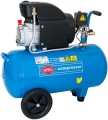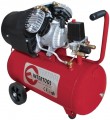Input performance
The amount of air that the compressor is able to process per unit of time; usually stated in liters per minute. Performance, along with pressure (see below), is one of the most important parameters: it is it that primarily determines how compatible the compressor will be with one or another pneumatic tool.
It is worth choosing a model according to this indicator in such a way that it can be guaranteed to “pull out” all the tools that can be connected at the same time. Air consumption is usually directly indicated in the characteristics of each tool, and it is quite simple to calculate the total requirement. However, due to the design features, the compressor must have a certain performance margin; the specific value of this stock depends on a number of nuances.
The main point is that some companies indicate for their units the performance at the outlet (how much air is supplied to the tool), while others indicate at the inlet (how much air the compressor sucks in). Since no compressor is perfect, part of the air is inevitably lost during the compression process, so the amount of air at the outlet will always be less than at the inlet. Accordingly, if the output performance is indicated in the characteristics, a margin of 10-20% is recommended, and if the input is 35-40%.
There are also more complex techniques that allow you to more accurately derive the required performance depending on the characteristics of specific tools; they can be found in...special sources.
Power
The power of the engine installed in the compressor. It is not the main parameter in evaluating the efficiency of the device — here the performance and nominal pressure play a decisive role (see above), and the engine is selected in such a way that its power is sufficient to ensure the claimed characteristics. However, this indicator still has practical significance: in compressors with an electric motor (and there are now most of them; see “Engine type”), the engine power determines the total energy consumption of the device, as well as the requirements for the network where it is planned to connect it (for more details, see “Voltage networks"). In addition, the power of the engine (regardless of its type) must be known in order to calculate the optimal performance value using some special formulas.
For internal combustion engines, power is traditionally expressed in horsepower (hp); you can convert it to watts in this way: 1 hp. = 735 W.
Number of cylinders
The number of cylinders provided for in the design of the compressor; by definition only indicated for reciprocating models (see "Compressor type"). This characteristic is primarily associated with performance indicators (see above). For example, values above 400 L / min among
single-cylinder units are rather rare exceptions; therefore, if you need a high performance reciprocating compressor, you should look into multi-cylinder models. The second application for multiple cylinders is a multi-stage operation scheme (see "Number of stages").
Noise level
The maximum noise level produced by the compressor during operation. When evaluating it, it must be taken into account that the decibel used to evaluate noise is not an absolute value. In fact, this means that noises, for example, 20 dB and 40 dB differ in level not by a factor of 2, but by 100 — it is this multiplicity that corresponds to a difference of 20 dB; a twofold increase corresponds to a 3 dB increase. Therefore, to assess noise levels, it is worth referring primarily to comparative tables. For values found in modern compressors, this table would look something like this:
70 dB — loud conversations at a distance of about 1 m;
75 dB — scream;
80 dB — motorcycle engine with silencer;
85 dB — loud scream;
90 dB — freight train car at a distance of 5-7 m;
95 dB — noise inside the subway car.
Anyway, the lower the level of noise produced by the unit, the more comfortable its use, the less it will “hit on the ears” and increase the volume of the entire set of working instruments.
Noise level (LPA)
The sound pressure level in decibels at a certain distance between the noise source and the ear of the compressor equipment operator. Since people do not work in the immediate vicinity of the compressor, the parameter will be useful for estimating the noise level at a distance. It is most often measured at a distance of 7 m from a working installation, less often at a distance of 1 m.

